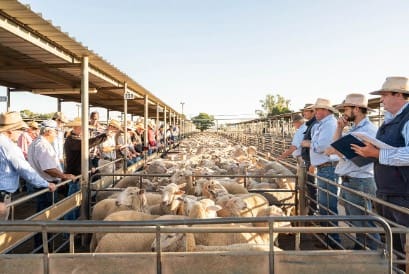
RECENT sheep and lamb electronic ear tag scanning results at the Wagga Wagga Livestock Marketing Centre in New South Wales have pleased government department officials overseeing implementation of the mandatory EID system in the state.
However, stock agents are regard the transition to EID across the state’s sheep flock an impost in time and cost, and they are expecting pushback from some producers.
The NSW Department of Primary Industries and Regional Development today said the Wagga Wagga Livestock Marketing Centre has taken a major step forward in the transition to electronic identification (eID) for sheep and goats, successfully scanning nearly 15,000 individual electronic identification devices during last month’s record sale.
Of the 77,127 sheep and lambs yarded at the sale, 18.8 percent were identified with EID devices—an impressively high figure considering only lambs born after 1 January 2025 are currently required to have an EID device, DPIRD said.
The process was carried out efficiently, with minimal errors and no delays, demonstrating the professionalism and preparedness of Wagga’s stock and station agents, the department said.
DPIRD said the positive scanning results from the recent Wagga sale are an encouraging sign of industry preparedness ahead of the next major EID implementation milestone in NSW.
A NSW DPIRD spokesperson said no animals were identified as missing a mandatory EID tag at the 10 April sale.
 “The NSW Department of Primary Industries and Regional Development (NSW DPIRD) has generally found that there is a good understanding of the key requirements of EID and the biosecurity threats that have necessitated this implementation.
“The NSW Department of Primary Industries and Regional Development (NSW DPIRD) has generally found that there is a good understanding of the key requirements of EID and the biosecurity threats that have necessitated this implementation.
“The NSW Government is committed to providing free sheep and goat EID education and training for all industry stakeholders to ensure widespread access and support,” the spokesperson said.
“This initiative aims to further enhance compliance and understanding among producers and agents, reinforcing the importance of eID in maintaining biosecurity standards.”
From 1 January 2027, all sheep and goats in NSW must have an electronic identification (EID) device prior to movement, and these early outcomes demonstrate strong progress toward that goal, DPIRD said.
However, Wagga Selling Agents Association president Isaac Hill said the 18.8pc figures represented the EID uptake of producers consigning to the saleyards and “next to none” were post 1 January 2025 drop lambs.
Mr Hill said from August onward there will be a rapid increase in the numbers of sheep and lambs with EID tags, but association members still feel the EID system has been imposed on them and producers.
“And that it is absolutely something that the agents now have to do.
“It’s costing us a lot more time and labour at the saleyards and will do,” he said.
He said many producers also feel that the EID system has been imposed on them and he is expecting that there will be an element of pushback from some producers.
“And if I use the comparison with the National Vendor Declaration form situation, we’re still getting 2013 NVDs and the new version has been out since 2020.
“So I would imagine that the NLIS (EWID) device (uptake) would be no different,” he said.
“There will be some mop-up tagging and scanning and there will be some letters sent and fines distributed at some time going forward.”
He expected there will be a need for further education of producers and the need for significant rebate schemes to achieve full uptake of the new EID system among producers.
NSW DPIRD director sheep & goat traceability, Kiowa Fenner, said Wagga has demonstrated what can be achieved through strong industry collaboration and commitment.
“The agents at Wagga LMC have shown exceptional leadership and professionalism in embracing the eID system, not just in meeting expectations, but exceeding them.
“Their success demonstrates the strength of partnerships between government and industry and reinforces our shared goal of building a modern, resilient traceability system for the future,” Ms Fenner said.
“Wagga is the largest saleyard in the southern hemisphere, and their agents have set a high benchmark for EID implementation across the state.”
The scanning was completed entirely by local agents without direct support from NSW DPIRD, Local Land Services or software providers on the day, highlighting the agents’ dedication and competence following months of preparation and training.
Ms Fenner said this level of performance speaks to the agents’ willingness to embrace the new system and their investment in getting it right.
“DPIRD’s Sheep and Goat EID team continues to work closely with saleyards, agents and producers to support the staged implementation of electronic identification across New South Wales, ensuring a smooth transition for the industry at every stage.”
For further information on the rollout of EID for sheep and goats in NSW, including upcoming deadlines and resources, producers can visit the NSW DPIRD website and subscribe to the NSW sheep and goat EID newsletter.

HAVE YOUR SAY